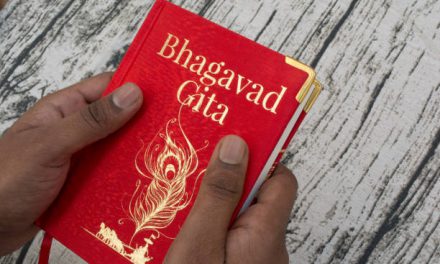![]() Prof Prabhu Guptara reviews the book Hinduism in Great Britain: The Perpetuation of Religion in an Allen Cultural Milieu. Professor Prabhu Guptara is Executive Director, Organisational Development, Wolfsberg (a subsidiary of UBS – one of the largest banks in the world). He is Chartered Fellow of the Chartered Institute of Personnel and Development; he is also Fellow: of the Institute of Directors, of the Royal Commonwealth Society, and of the Royal Society for the Encouragement of the Arts Commerce and Manufactures.
Prof Prabhu Guptara reviews the book Hinduism in Great Britain: The Perpetuation of Religion in an Allen Cultural Milieu. Professor Prabhu Guptara is Executive Director, Organisational Development, Wolfsberg (a subsidiary of UBS – one of the largest banks in the world). He is Chartered Fellow of the Chartered Institute of Personnel and Development; he is also Fellow: of the Institute of Directors, of the Royal Commonwealth Society, and of the Royal Society for the Encouragement of the Arts Commerce and Manufactures.
By the 1960s, there were large enough numbers of Hindu lay people living in several British cities for them to begin to organize themselves for religious purposes; now, twenty years later, there are over a hundred Hindu temples and the number is increasing. The preservation of religious life in Britain raises complex issues about the relation between religion, culture, and territory in Hindu society. How are these religious traditions to perpetuate themselves in an alien environment? To what extent are Hindus affected by religious disputes centred in India? In what ways have Hindus reinterpreted their beliefs in the light of their Western experience? These are some of the issues examined in this book.
A collection of papers is notoriously difficult to review. Let me begin indicating the scope of the material. David Bowen examines the evolution Gujarati Hindu organizations in Bradford, while Maureen Michaelson and Merryle McDonald argue for the centrality of the Hindu family in the perpetuation of Hindu ideas and practices. Werner Menski focuses on the relation between Brahminism, local traditions and British legal tradition. One particular Gujarati caste is described by Rohit Barot, who reflects on the ways in which that caste is developing in Britain. Donald Taylor, in two papers, examines the formation of a Saivite ashram and the development of the Sathya Sai Baba movement here. Sean Carey, also in two papers, discusses the fortunes of the Ramakrishna Mission, and the Indianisation of ISKCON (International Society for Krishna Consciousness or Hare Krishna group) after the death of its founder. Robert Jackson and Kim Knott tackle what is, in many ways, the most interesting question raised by the volume: has the presence of Hindus in Britain contributed to a redefinition of their religion? Do such reinterpretations "betoken the existence of what might be called `British Hinduism' "?
The authors sidestep the question at first, and then concede that "certain changes do appear to have occurred". Some of these changes are: "authoritative statements from respectable Hindu laymen" — as distinct from ascetics and philosophers — about the universal dharma; expecting religious rituals and statements to have a meaning; expecting religion to offer them something personally; accepting the validity of the question of personal identity. In coming to see their religion in these ways, say the authors, Hindus "have begun to see Hinduism through foreign eyes". Yet, having gone so far, they rapidly backtrack: "The fact that Hindu spokesmen in Britain are changing Hinduism by redefining it in relation to other beliefs is as old as Hinduism itself" — a bit of tautology, whose truth depends on when one considers. "Hinduism" to have begun. Further, they do not ask the seminal question, if Hindus have always redefined their beliefs or practices in relation to other beliefs, have the British-Hindu definitions been similar to or different from the earlier redefinitions?
The fact is that the notion of "Hinduism" is a liability for scholars. It should be evident by now that there is no such thing; there are various traditions of thought and practice among people who are called "Hindus ", and the various traditions have nothing in common among themselves absolutely, though there is a relative overlap in many of their ideas and practices.
Apart from this fundamental error, from which many Western scholars still seem unable to detach themselves, it is possible to niggle about several minor matters. For example, the writers appear unaware that the "National Council for, Hindu Temples" started out as a front organization for ISKCON. Then there are some examples of loose thinking — e.g. Hindus regard their own religious ceremonies as the "real" marriage, whereas the State of course regards the civil ceremony as the "real " marriage; this leads the editor to conclude that "Hindus in Britain have created a pluralistic legal situation ", whereas the actual situation is that two ceremonies take place, both tolerated by the two parties (the state and the religious community involved), and that each regards only their own ceremony as the "real" marriage. Moreover, it is not the Hindus who have "created" this situation. The situation is exactly the same with regard to other religious communities (Christian, Muslim, Jewish, Parsi) – and so considerably predates the Hindu situation here.
The most surprising lacuna in the scholarship of the book does not arise in connection with Hindus. It arises in connection with Christianity: their notions of Christianity are based on "Western scholarship about Christianity" rather on the self-descriptions of Christians; if the authors did examine these self-descriptions, they would find these rather similar to the self-descriptions of the Hindus, for example insofar as their notions of God and of miracles are concerned.
However, this volume offers massive, original and much-needed data on an important contemporary phenomenon, of interest to students of religion, history and sociology. Most of it is thoroughly readable, and there is an excellent bibliography by Helen Kanitkar, which is itself thoughtfully classified and indexed.
About the book: Hinduism in Great Britain: The Perpetuation of Religion in an Allen Cultural Milieu. Ed. Richard Burghart. London, Tavistock Publications, 1987. Pp. 290. Map. Bibliog. Index. £27.00
Read Prabhu S Guptara regular musings at http://www.prabhuguptara.blogspot.com/ and visit his website http://www.prabhu.guptara.net/ to read more of his articles.
This review was first published in The Journal of the Royal Asiatic Society, Spring 1988. Reprinted with author’s permission.
{moscomment}




